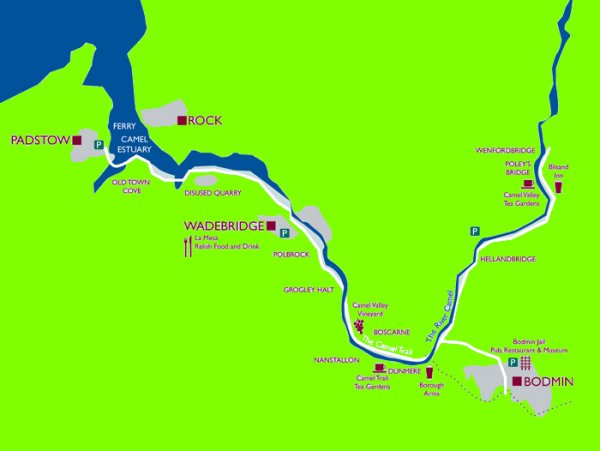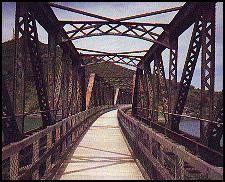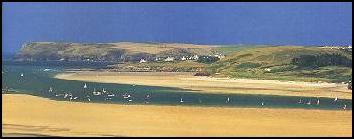

Email: countrysideservice@cormacltd.co.uk
Web: www.cornwall.gov.uk/cameltrail
Enjoy the spectacular scenery of
the Camel River and Estuary on Cornwall's North Coast
A tract of beautiful countryside for over seventeen miles in total, The trail goes from Wadebridge to Padstow and from Wadebridge to Wenfordbridge, near St.Breward. The whole of the trail is level and follows the River Camel for most of the way, and it used to be part of the Bodmin and Wadebridge Railway which closed to trains in 1967, freight finally ceased in 1983, when a need to invest in new track forced closure of the line and re-opened as The Camel Trail for walkers and cyclists in 1985. There are refreshments available along the way and The Borough Arms, near Bodmin is located right on the Trail, and also provides parking. Bike hire is in plentiful supply in Wadebridge with shops in Eddystone Road, at the start of the Wadebridge to Padstow stretch of the trail. The trail is also popular for bird watchers, with a purpose built bird hide half way between Wadebridge and Padstow. An extension known as The Camelford Way now extends the trail as a footpath on to Camelford.
The railway was built so that the trains would not have any steep inclines or sharp turns. It is these characteristics which make it an excellent cycle trail. Since the trail has been open to the public cycle hire shops, cafes and other attractions have sprung up to cater for the traffic. Many families take their young children to the trail to allow them to become more confident cyclists in a traffic free environment. The local cycle hire shops have a wide range of tag-alongs or buggies to allow very young children to be safely transported behind their parents. Only a small part of the trail, through Wadebridge, is on roads and shared with normal traffic.
In 2006 two extensions to the trail were completed. The first was from Scarlett’s Well car park in Bodmin up into the town. The second was from Poley's Bridge, near St.Breward to Wenford Bridge through the old clay dries, which was made possible by Imerys donating the land.
The trail easily divides into three sections each of which is approximately six miles long.
Padstow to Wadebridge - 5.5 Miles
Wadebridge to Boscarne (Bodmin) - 5.75 Miles
Boscarne to Wenford Bridge - 6.25 Miles
Midway between Bodmin and Wadebridge is The Camel Trail Tea Garden making it an ideal stop along the way. Or going the other way The Snail Pace Cafe up at Wenford Bridge.

There is an extraordinary array of wildlife to be appreciated along the Camel Trail. Look for signs of secretive mammals such as fox, badger, rabbit, deer and rarities like otter and greater horseshoe bat. Coppiced hazel is the home of the dormouse. A few wild service trees have sprung up among the oak, spindle and sycamore. See foxglove, campion, mullein, madder; violets and snowdrops appear as early as December in some years. Thistle seeds provide food for the goldfinches. The River Camel supports salmon and trout, dipper and kingfisher; on the estuary live bass and mullet, curlew and shelduck; an ever-increasing number of little egrets now live alongside the local herons.
The short story "Cuckoo Valley Railway", written by Sir Arthur Quiller-Couch ("Q" to the world), is certainly a thinly-disguised tale of Bodmin and its railway. The Camel Trail now follows this, the line of one of the world's very first steam railways. Opened in 1834, the Bodmin and Wadebridge Railway was originally built to carry sea sand from the Camel estuary to sweeten the acidic farm soils inland. Granite and china clay made the return trip for shipping out from Wadebridge. The railway soon began to carry passengers and offered a variety of day trips and excursions including flower shows, bazaars and swimming competitions. Amongst the most popular were those to watch the public hangings at Bodmin Jail.
In 1846 the London and South Western Railway (LSWR) bought the BWR, the first shot in a long, hard-fought battle for supremacy between supporters of broad gauge and standard gauge railways. In 1899 the line from Wadebridge to Padstow was laid, starting the route of the Atlantic Coast Express which carried thousands of holiday-makers to the west country until the line's closure in 1967.
Perhaps the most famous of those travellers was the Poet Laureate Sir John Betjeman, for whom the railway, the river and estuary were a great source of inspiration.
The costs of maintaining this facility are paid by Cornwall County Council. A donation would be appreciated to ensure the continued existence of the Camel Trail as a recreational route.
Being an old railway track the Trail is virtually level all the way. Although not a tarmac surface it is mainly smooth, ideal for wheelchair users, pram and buggy pushers and people who have difficulty in walking on uneven surfaces. The Trail provides safe and easy access to unspoilt countryside for those people unable to use woodland and coastal paths.

The Camel Estuary The Camelford Way Bodmin Padstow Wadebridge Camel Valley Vineyard
St.Breward Bodmin Steam Railway Cornish Cafes Cycling in Cornwall Walks and Walking in Cornwall